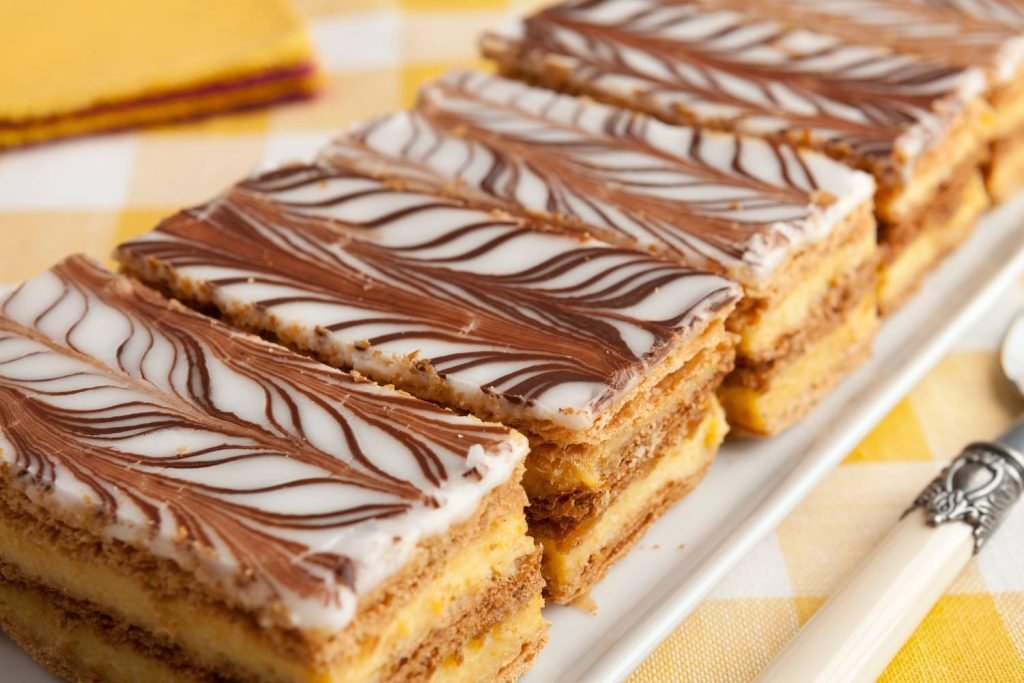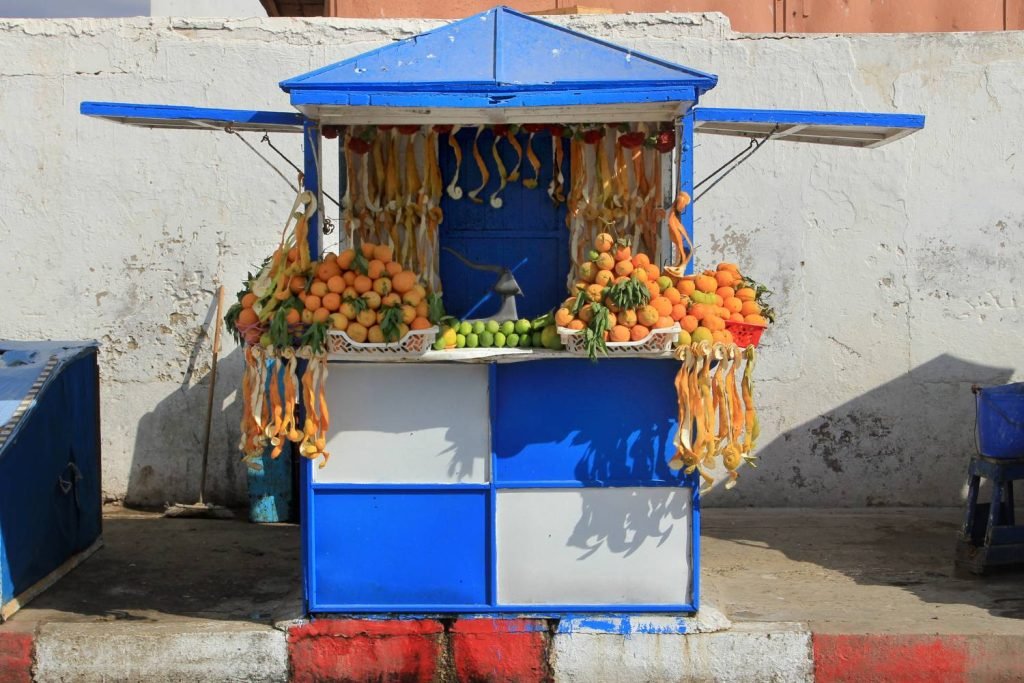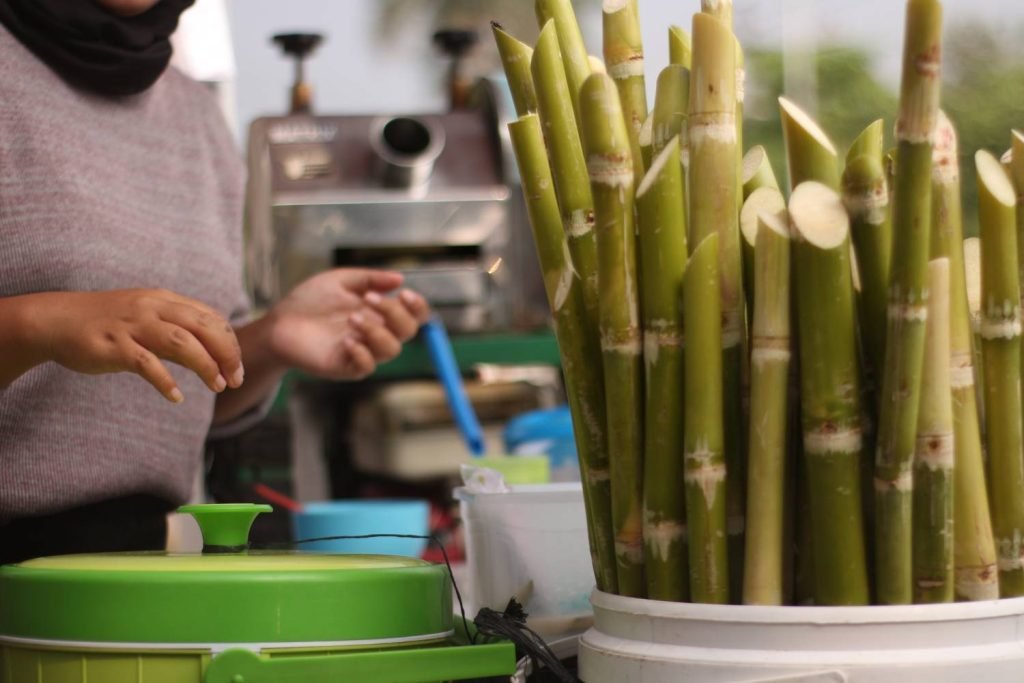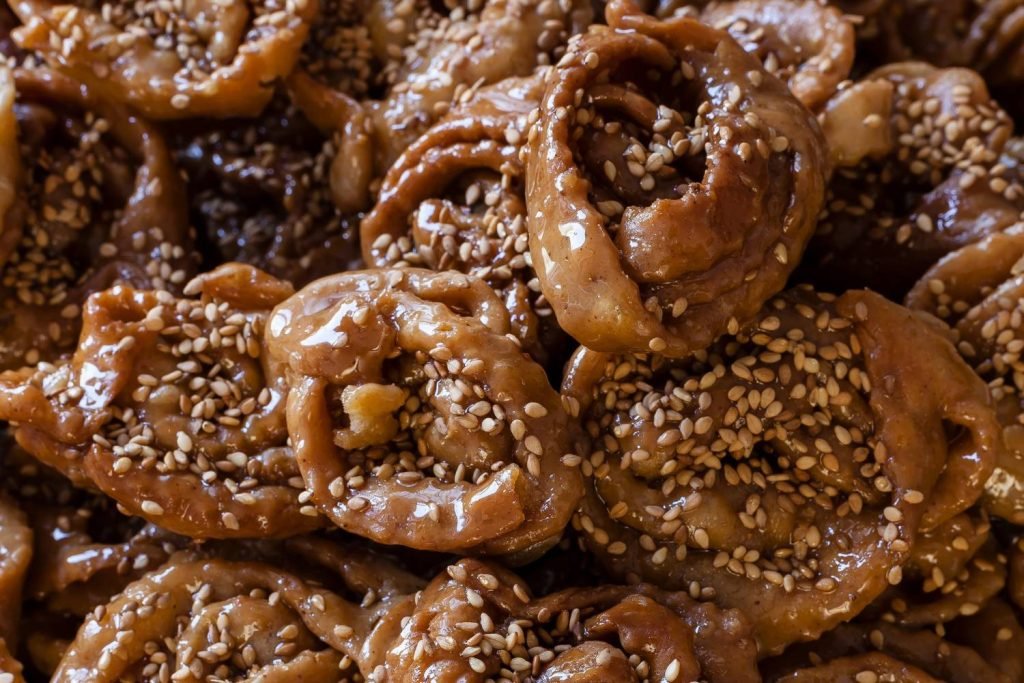Let’s take a delicious (and adventurous) stroll through the lively medinas of Morocco, where you’ll find stalls and carts selling Moroccan street foods to suit every craving.
Imagine: the smell of onions & spice wafting from rghaif being flipped by hand on a giant griddle, olives in every color of the rainbow, and piles of sweet, honey-drenched chebakia calling your name. Hungry yet?
After visiting over 20 towns and cities in Morocco (and living in Rabat for 9 months during my gap year), this is my list of must-try street foods to get a true taste of Moroccan culture. From the midst of Marrakech’s bustling square to tiny fishing towns along the rocky coast, you’ll find not only warm & comforting traditional Moroccan cuisine, but also dishes that will pique the curiosity of even the most adventurous eaters.
Let’s get started on this tasty adventure as we celebrate the diverse array of Moroccan street food – a true sensory delight!
P.S. I’ve arranged these from “mild to wild,” so pick your level of culinary adventurousness and scroll accordingly 😛

15 Must-Try Moroccan Street Foods
Moroccan Street Food: Sweets & Desserts
1. Sfenj (Moroccan Doughnuts)

On the outskirts of any Moroccan medina (the old, walled part of the city), or along popular walking commutes, you’ll find stalls with golden & crispy sfenj sizzling away in a hot oil bath. Ask for one of these Moroccan-style doughnuts served on a stick or piece of heavy paper, or order a “cornet” of mini ones in a paper cone. Either way, they’ll come sprinkled with crystalized sugar and be piping hot (so be careful and watch out for hot oil drips).
2. Candied Peanuts

Candied nuts are found everywhere in the medina – there are entire stalls dedicated to selling different kinds, covered with sugar and spices, or preserved within cubes of chewy nougat. My personal favorite were the candied peanuts. Getting them from a vendor stirring a vat of them over a fire also ensures they’ll still be a little soft (much safer for your teeth).
3. Mille Feuille

While not technically a street food, this French pastry is very popular in Morocco (a remnant of French colonization of the country in the 20th century) and you’ll find lots of good bakeries with cheap mille feuille and other pastries. As a general rule, I’d recommend purchasing pastries and cookies from a bakery rather than a street food stall, for better quality & food safety.
4. Fresh-Squeezed Orange Juice

In Morocco’s mediterranean climate, oranges are plentiful and cheap, so fresh-squeezed orange juice is one of my favorite indulgences. You’ll see some places using small, super-sweet clementines, and others using large, juicy navel oranges – all are delicious!
My one note of caution with fresh juices is that sometimes you’ll see street vendors water down the juice – and even if it’s coming out of what looks like a bottled water, it’s likely tap water (in a reused bottle). So, if you’re only in Morocco for a short time and are avoiding tap water to avoid the stomach acclimatization period, this street beverage is one you may need to be extra cautious around.
5. Sugarcane Juice

You may have had fresh squeezed juice, but sugar cane juice gives pressed juice a whole new meaning. Anywhere you see tall stalks of sugarcane, they’ll probably juice it for you on the spot. If you haven’t tried it before, it’s less sweet than you’d expect – with a hydrating, sweet and green/grassy flavor.
6. Chebakia

Ahh, chebakia… These sugary treats are made from a sweet dough that is shaped, fried, submerged in honey, and then sprinkled with sesame seeds. The honey immersion after frying gives them this chewy-crispy texture that is truly incredible, especially when you can find them fresh and still warm. These are a traditional Moroccan dessert associated with Ramadan, but you can find them year round in the medina.
Moroccan Street Food: Savory Snacks

(no photos for these next two, so enjoy an image of the vibrant pyramids of spices you’ll also see in the medina. Turmeric, paprika, and cumin are all in here – what else can you see?)
7. Kefta & Merguez Sandwiches
You’ll find these common sandwiches from convenience shops, khobz (bread) carts, and food stalls. They are made with the basic round khobz loaf, sliced partway through and stuffed with either a spiced ground meat mixture (kefta – usually some combination of beef and lamb), or merguez (moroccan sausages). These are a cheap and convenient meal when you want to keep moving, or pick something up to take down to the beach.
8. Briouat / Briwat
Briouat are small, triangular phyllo dough pastries with a spiced ground meat/kefta filling. The phyllo dough is folded around a spoonful of filling and then they are fried until golden brown. These are a great snack for meat eaters, just look for ones that are fresh and where the oil is within sight and reasonably clear.
9. Zeitun (Olives)

Moroccan is the third-largest exporter of table olives in the world, so they are an absolute must-try when in Morocco (even if you’re not typically an olive fan).
The most common olive varietal in Morocco is the picholine olive, a light green, firm olive with a lemony and briny flavor. You can get these plain, or spicy – mixed with harissa, a red chile paste. I also suggest trying the shriveled black olives, which are cured by layering them in salt, and have a rich, deep (and very salty) flavor. Those are just my two favorite types, but there are many more to choose from!
10. Tayb O’hari / Hammas Kamoun

Tayb O’hari (you may also hear it called “hammas kamoun” ) are roasted broad beans or chickpeas with cumin. Cumin is the most widely used spice in Morocco – you’ll find it in almost every traditional dish, from soups to tagines, and in this traditional street food, cumin again plays a starring role. This is a great street food to grab when you need something savory, filling, and energizing. These are also most commonly served from a giant stock pot into a paper cone, and are moderately crispy. I’ve tried recreating these in my air fryer at home, but it’s not quite the same.
11. Stuffed Rghaif/Msemmen

Msemmen, also called rghaif depending where in Morocco you are, is a flatbread very similar to roti or chapati. These are made from a simple dough, folded and brushed with oil, hand stretched, sprinkled with semolina flour, and cooked on a large griddle until golden brown spots appear on each side.
Their flaky and chewy layers are even better (in my opinion) when a mouthwatering mixture of onions, harissa, and olives are added in during the folding process. These stuffed msemmen are one of the most satisfying Moroccan street foods, and are fun to try in different cities or different stalls as everyone has their own spin on the stuffing mixture.
Moroccan Street Food: for the More Adventurous
12. Avocado Date Juice(Smoothie)

Morocco is where I first fell in love with putting avocados in smoothies. Might sound kind of weird, but avocado “juice” with dates is magical, sweet, and creamy. You can typically order this at any juice bar type restaurant, or from juice stands where they clearly have a mix of fruits on display.
13. Hendia (Prickly Pear Cactus Fruit)

Prickly pear cactus fruits are one street food slash produce market crossover that you’ll see piled on wooden carts with discarded skins likely littering the ground around them. Walk up to the person at the cart and you can have one peeled for you. The most common variety has a vibrant, beet-purple color interior (that will stain), can be slightly sour, and is the perfect afternoon treat on a hot summer day. They do have small, hard seeds that you can’t bite through, but you can either swallow them or spit them out.
14. Babbouche (Snails in Broth)

Babbouche is a traditional Moroccan street food that is common in coastal cities, and consists of snails boiled in a savory, salty broth. You can order them with the broth, served in a small cup you can sip from, or without the broth, served with toothpicks to pluck out the snail meat. Though maybe not as high-class as escargot, the simple flavors are nonetheless delicious and make this a must-try for adventurous eaters in Morocco.
15. Sea Urchin

Yes, for real! You won’t find these as a street food everywhere in Morocco, but you will in coastal seafood-focused towns such as Oualidia, the oyster capital of Morocco. You’ll find street vendors with baskets of purple sea urchins ready to halve them and offer to you with or without a spoon and a slice of lemon. Bottoms up!
I tried sea urchin the same day I first tried oysters – and honestly, I might’ve liked the sea urchin better at that point? I’ve had a lot more opportunities to try oysters since then, but haven’t come across sea urchin again...
FAQ: Is it safe to eat street food in Morocco?
If you have a sensitive stomach, I’d suggest avoiding raw fruits & vegetables – particularly ones where you eat the exterior, as they’re washed in tap water and can cause upset stomachs. For instance – while eating a prickly pear (insides) is usually safe, eating a fresh fig could be a bit risky if you eat the skin. And again, if you order juice, pay attention to make sure it isn’t being watered down with tap water (even if it looks like the water is coming from a labeled water bottle).
For fried foods, I’ve never personally had a problem with these, but it’s always a good idea to check the oil is light and clear, and that the item you select is warm and seems fresh. Watch what locals do, never eat at an empty place or one without a line if other options with more people queued are nearby.
As an adventurous eater, sometimes I’ve made the conscious decision to eat something a little bit risky for the experience. And 9/10 times, I haven’t had an issue. But I also feel more confident in my decisions knowing that I am prepared with 1) the Hepatitis A vaccine, recommended by the CDC for travelers to Morocco, 2) immodium, pepto-bismol tablets, and electrolyte tablets, and 3) travel insurance that covers medical. Always be the best-prepared you can be, and then take the risks you are comfortable with!
FAQ: How do I pick the “best” street food stand?
While you can easily wander any medina and find stalls selling most of these foods, if you’re a solo traveler looking for a communal culinary experience, or would prefer to eat only at pre-vetted stalls, I’d recommend booking a Marrakech street food tour.
You could also look into cooking class experiences, which I was lucky enough to do with a group of friends while I lived in Rabat. If you are visiting Marrakech, I can highly recommend the cooking classes offered by the Amal Center, a nonprofit dedicated to Moroccan women’s empowerment and financial independence.
Looking for more adventurous activities to do in Morocco? Check out my guide to 8 uniquely Moroccan cultural experiences!
Leave a Reply